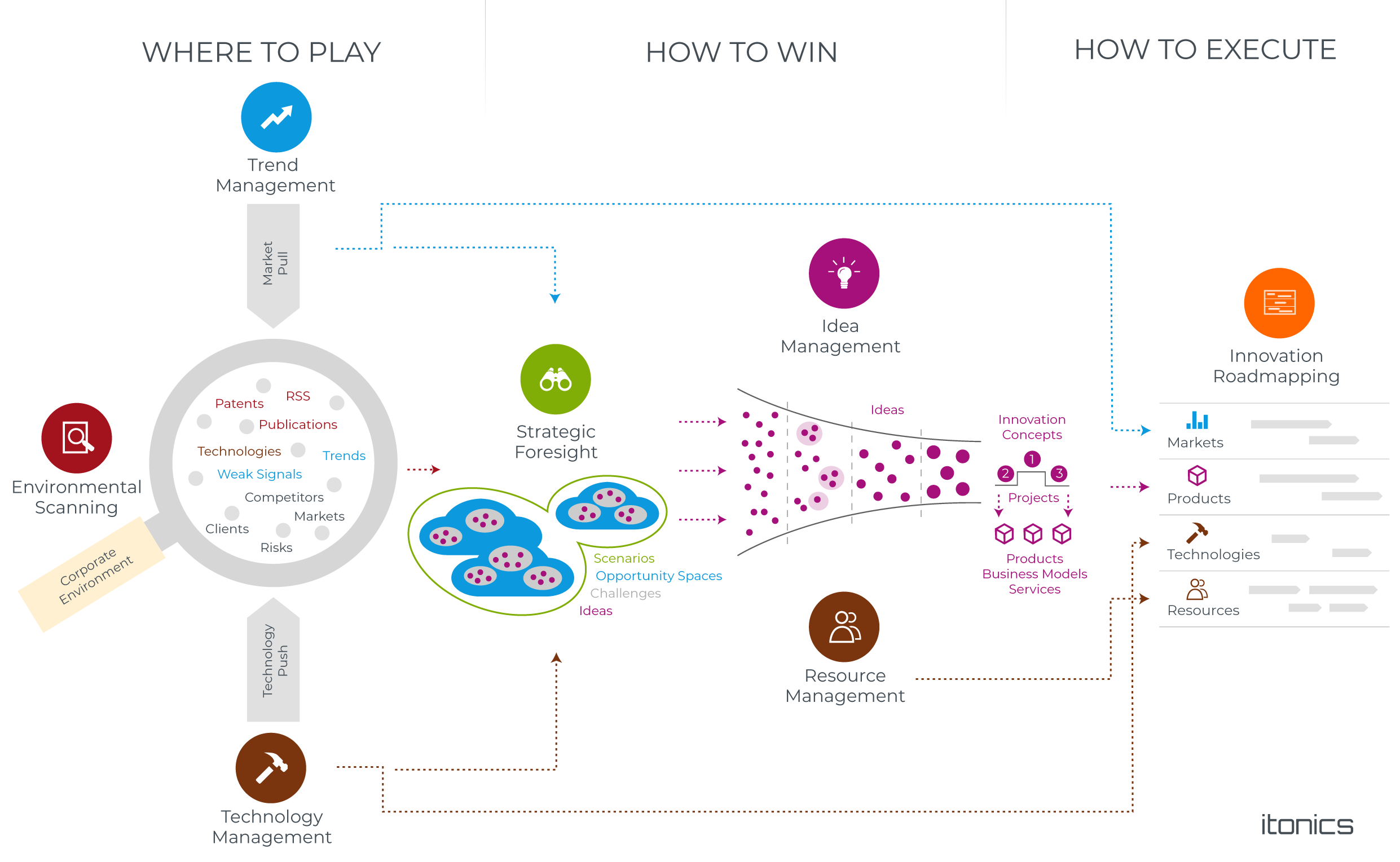Digitization, new business models and disruptive technologies are driving complexity in every single industry.
For businesses today, effective strategy and innovation management is critical for driving digital transformation, and that requires robust approaches and tools that enable collaboration and agility.
Yet the word ‘ideation’ has been overused as a synonym to ‘innovation’. Why? To ‘innovate’, companies often times put the most creative employees and experts in a lab room to develop brilliant concepts or run ideation programs to collect ideas and pick the most promising ones, then hope for magic.
Maybe this has worked years back or in some individual cases, but it is definitely not a sustainable way of innovating. It is a myth that an idea emerges from nowhere in what we call the ‘Aha or Eureka Moment’.
Innovation starts with information, the many individual snippets and inspirations between which we make connections and seemingly combine them, in an instant, into a new concept. Everyone, from Albert Einstein to Design Thinkers, is known to start with information. Why many innovation management platforms have hijacked the Front End of Innovation supporting solely ideation is simple; it is more attractive.
Did Grundig collapse into bankruptcy just because nobody in the company was aware of the high-quality low-price business strategy of Sony and Samsung? Did Kodak fall down because it was unaware of the emerging digital trends? Most likely not. It could be that in each case there were great ideas inside Grundig or Kodak, but ideas should come from a thorough environmental scanning process and strategy alignment, and have a robust follow-through process.
Simply put, innovation is much more than ideation or out-of-the-box ideas — it should provide answers to these three simple questions as parts of one holistic strategy: ‘Where to play?’, ‘How to win?’ and ‘How to execute?’.
Let’s address the questions above by exploring the separate pieces and the process of integrated innovation management.
 Where to play?
Where to play?
Before ideating, a good question to answer is: Where to ideate? What is the next big thing that our existing or new clients need? In which business areas is future growth possible or even necessary? The target of ‘Where to play’ is the identification of trends, technologies, patents, publications, inspirations or startups relevant to your business environment.
In order to find out where you should play the innovation game, the following data sources should be studied:
Trends represent the environment of the business and reflect consumer needs and changing consumer behaviors over time. Trend scouting helps you to focus on the analysis of your business environment and gain a competitive advantage.
Technologies help you to do a foresight of what technology trends are relevant to the problem you are trying to solve – currently or in the future – and which capabilities or resources are necessary to create this or that technology. Scientific publications or patent databases, in particular, are used as a source for identifying new technologies and sustainably pushing innovation and R&D performance.
Inspirations are early real-life examples of how trends and technologies are used by first movers. Inspirations are sometimes derived from different industries that potentially could lead to the cross-industry application of a specific trend and/or technology.
Startups are one of the fastest rising innovation sources for corporates. Startup scouting and monitoring play a great role in building potential future partnerships or investments to create disruptive products, services, and business models.
This work forms the basis for all subsequent steps of a holistic innovation process.
Based on the wealth of different information gathered through environmental scanning, it is now possible to create links and dependencies that result in a comprehensive pattern. The evaluation of each individual component (e.g. based on the relevance or the disruption potential for one’s own company) results in so-called advantageous areas for growth and innovation as well as areas of risk, which should be monitored with increasing caution.
How to win?
The next phase, ‘How to win’, is where ideas are brought into play. All the knowledge coming from ‘Where to play’ can be directed towards targeted idea development and management. Ideation campaigns executed only after vigorous environmental scanning and monitoring of trends and technologies, will add strategic value to your innovative direction.
Here the challenge is to define which strategic innovation fields are necessary for new products and services, who should be the contributors regarding those topics and how to transform well-researched ideas into real innovation projects.
Some questions to ask yourself:
- How do I address my defined innovation opportunity spaces with the help of targeted ideation?
- Which ideas support the achievement of the planned strategic direction?
- How do I create a sustainable and balanced innovation portfolio based on individual ideas?
Besides running collaborative ideation campaigns, it is key to also get an overview of your current innovation portfolio. Which existing innovation projects should be accelerated, killed, or postponed? By linking your current innovation projects to trends and upcoming technologies you identify “white spots” in your portfolio. Constantly monitor innovation activities and their relevance to find the right balance of core and transformational innovation projects. Create portfolios that include quick wins, midterm investments and a view on your long term investments to get the most out of your innovation activities.
How to execute?
Now it is time to transform your projects and ideas to future-proof innovations.
Every innovation project is unique and that is why it has different requirements. Thus, the innovation project execution process is expected to be visually presented through integrated technology and product roadmaps to execute and manage your innovation strategy.
At this stage, it is key to visualize and contextualize dependencies between markets, products, technologies, and resources across all business units and facilitate medium to long-term product and technology planning.
- Which business models support a successful market launch?
- Does my innovation roadmap contain enough products and technologies to serve existing and future markets?
- What investments must be made in internal and external capabilities, know-how and resources to ensure the development of new products and technologies?
- How do I identify needs, synergies, time inconsistencies, and gaps in technology and product development across all business units?
‘Innovation is not ideation’ is the first principle you should consider when implementing a comprehensive innovation management process starting with scanning and identifying relevant trends and technologies to uncover the right strategic innovation fields for growth and success.
 This is a guest post by Shushanik Hakobyan, Market Insights Researcher at ITONICS. ITONICS is a leading provider of software solutions and consulting for innovation management and growth strategies. With the modular software suite, companies can collect, connect and track relevant information, inspirations, ideas, initiatives, and projects. The innovation strategy can be actively shaped and managed – from trend, technology and idea management all the way to technology and product roadmapping. Innovation leaders around the globe rely on the professionalism of ITONICS such as Audi, BMW, CISCO, INTEL, PepsiCo, Siemens, and Total.
This is a guest post by Shushanik Hakobyan, Market Insights Researcher at ITONICS. ITONICS is a leading provider of software solutions and consulting for innovation management and growth strategies. With the modular software suite, companies can collect, connect and track relevant information, inspirations, ideas, initiatives, and projects. The innovation strategy can be actively shaped and managed – from trend, technology and idea management all the way to technology and product roadmapping. Innovation leaders around the globe rely on the professionalism of ITONICS such as Audi, BMW, CISCO, INTEL, PepsiCo, Siemens, and Total.

